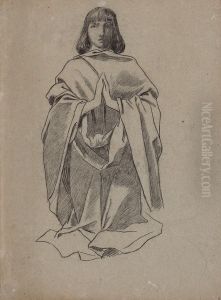Ricardo Bellver Paintings
Ricardo Bellver was a prominent Spanish sculptor, born on February 24, 1845, in Valencia, Spain. He moved to Madrid with his family at a young age, where he would later develop his artistic talents. Bellver studied at the Real Academia de Bellas Artes de San Fernando in Madrid. His education there was instrumental in shaping his classical style, which was heavily influenced by the works of the Renaissance and Baroque periods.
In 1878, Bellver achieved international acclaim for his masterpiece 'El Ángel Caído' (The Fallen Angel), which was originally created as a plaster sculpture for the National Exhibition of Fine Arts (Exposición Nacional de Bellas Artes) in Madrid. The piece was inspired by a verse from John Milton's epic poem 'Paradise Lost' and depicts Lucifer being cast out of Heaven. This notable work earned him a first-class medal and was subsequently purchased by the Spanish state.
Following his success, Bellver was granted a scholarship to study in Rome, where he resided from 1878 to 1882. His time in Italy had a profound impact on his work, allowing him to study classical sculpture firsthand and refine his technique. Upon his return to Spain, 'El Ángel Caído' was cast in bronze and placed in the Parque del Buen Retiro in Madrid, where it remains a significant cultural landmark.
Throughout his career, Bellver continued to produce works that were well-received by the public and critics alike. He became a respected member of the artistic community, earning a position as an academic at the Real Academia de Bellas Artes de San Fernando and receiving various honors and distinctions. His contributions to sculpture and his representation of the human form were celebrated for their dynamism and emotional expression.
Ricardo Bellver passed away on December 20, 1924, in Madrid. His legacy is preserved through his sculptures, which continue to be admired for their technical mastery and artistic beauty. 'El Ángel Caído' in particular is considered one of the finest examples of 19th-century Spanish sculpture and remains an iconic piece within the canon of Western art history.
